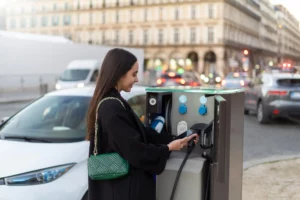
Home / EV Charging News / How EV Battery Cooling Systems Operate
Electric vehicles (EVs) have become increasingly popular as the world shifts toward more sustainable forms of transportation. A critical component of any EV is its battery, which stores the energy needed to power the vehicle. However, like any battery, the one in an EV generates heat during operation. Managing this heat is crucial for maintaining battery performance, longevity, and safety. This article delves into how EV battery cooling systems operate, ensuring that these high-energy devices function efficiently and reliably.
Before diving into the specifics of how cooling systems work, it’s essential to understand why they are necessary. EV batteries generate heat during both charging and discharging processes. Excessive heat can degrade the battery’s materials, reduce its lifespan, and, in extreme cases, lead to dangerous conditions such as thermal runaway, where the battery overheats uncontrollably. Therefore, an effective cooling system is vital to maintaining the battery’s optimal operating temperature, ensuring safety, and preserving performance.
There are several types of cooling systems used in EVs, each with its advantages and limitations. The choice of system often depends on the vehicle’s design, battery type, and intended use. The main types of cooling systems include:
Air cooling is one of the simplest methods for managing battery temperature. This system uses fans to blow air over the battery pack, dissipating heat into the surrounding environment. While air cooling is relatively inexpensive and straightforward, it is less effective at removing heat compared to other methods. It is commonly found in older or lower-performance EVs where extreme heat management is less critical.
Pros:
Cons:
Liquid cooling systems are more efficient than air cooling and are commonly used in modern EVs, particularly in high-performance models. These systems circulate a coolant, typically a mixture of water and glycol, through channels or tubes surrounding the battery cells. As the coolant absorbs heat from the battery, it is then passed through a radiator or heat exchanger, where the heat is dissipated before the coolant is recirculated.
Pros:
Cons:
A more advanced method involves phase-change materials (PCMs), which absorb heat as they change from solid to liquid. These materials are placed in direct contact with the battery cells. As the battery generates heat, the PCM absorbs this energy, maintaining a stable temperature. This system is particularly effective at handling short bursts of high heat, making it ideal for high-performance applications.
Pros:
Cons:
Effective battery cooling systems in EVs are not just about moving heat away from the battery; they also involve sophisticated monitoring and control systems. Sensors embedded in the battery pack continuously monitor the temperature at various points. The data collected by these sensors is fed into the vehicle’s Battery Management System (BMS), which adjusts the cooling system’s operation to maintain optimal temperatures.
As EV technology continues to evolve, so do the methods for managing battery temperature. Emerging technologies such as immersion cooling, where the battery is submerged in a non-conductive coolant, promise even greater efficiency and safety. Additionally, advances in battery chemistry may lead to batteries that generate less heat, reducing the need for complex cooling systems.
Understanding how EV battery cooling systems operate is crucial for appreciating the complexities involved in maintaining battery health and vehicle performance. As electric vehicles continue to advance, so too will the methods for keeping their batteries cool, ensuring that these vital components remain safe, efficient, and long-lasting. Whether through air, liquid, or phase-change materials, the future of battery cooling looks set to support the ongoing growth of the electric vehicle market.
